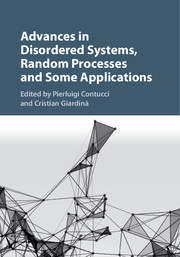Book contents
- Frontmatter
- Contents
- List of Contributors
- Preface
- 1 Topological Field Theory of Data: Mining Data Beyond Complex Networks
- 2 A Random Walk in Diffusion Phenomena and Statistical Mechanics
- 3 Legendre Structures in Statistical Mechanics for Ordered and Disordered Systems
- 4 Extrema of Log-correlated Random Variables: Principles and Examples
- 5 Scaling Limits, Brownian Loops, and Conformal Fields
- 6 The Brownian Web, the Brownian Net, and their Universality
- Index
6 - The Brownian Web, the Brownian Net, and their Universality
Published online by Cambridge University Press: 19 January 2017
- Frontmatter
- Contents
- List of Contributors
- Preface
- 1 Topological Field Theory of Data: Mining Data Beyond Complex Networks
- 2 A Random Walk in Diffusion Phenomena and Statistical Mechanics
- 3 Legendre Structures in Statistical Mechanics for Ordered and Disordered Systems
- 4 Extrema of Log-correlated Random Variables: Principles and Examples
- 5 Scaling Limits, Brownian Loops, and Conformal Fields
- 6 The Brownian Web, the Brownian Net, and their Universality
- Index
Summary
Introduction
The Brownian web originated from the work of Arratia's Ph.D. thesis [1], where he studied diffusive scaling limits of coalescing random walk paths starting from everywhere on Z, which can be seen as the spatial genealogies of the population in the dual voter model on Z. Arratia showed that the collection of coalescing random walks converge to a collection of coalescing Brownian motions on R, starting from every point on R at time 0. Subsequently, Arratia [2] attempted to generalize his result by constructing a system of coalescing Brownian motions starting from everywhere in the space-time plane R2, which would be the scaling limit of coalescing random walk paths starting from everywhere on Z at every time t ∊ R. However, the manuscript [2] was never completed, even though fundamental ideas have been laid down. This topic remained dormant until Tόth and Werner [99] discovered a surprising connection between the one-dimensional space-time coalescing Brownian motions that Arratia tried to construct, and an unusual process called the true self-repelling motion, which is repelled by its own local time profile. Building on ideas from [2], Tόth and Werner [99] gave a construction of the system of space-time coalescing Brownian motions, and then used it to construct the true self-repelling motion.
On the other hand, Fontes, Isopi, Newman and Stein [37] discovered that this system of space-time coalescing Brownian motions also arises in the study of aging and scaling limits of one-dimensional spin systems. To establish weak convergence of discrete models to the system of coalescing Brownian motions, Fontes et al. [38, 40] introduced a topology that the system of coalescing Brownian motions starting from every space-time point can be realized as a random variable taking values in a Polish space, and they named this random variable the Brownian web. An extension to the Brownian web was later introduced by the authors in [86], and independently by Newman, Ravishankar and Schertzer in [73].
- Type
- Chapter
- Information
- Publisher: Cambridge University PressPrint publication year: 2016
- 18
- Cited by



